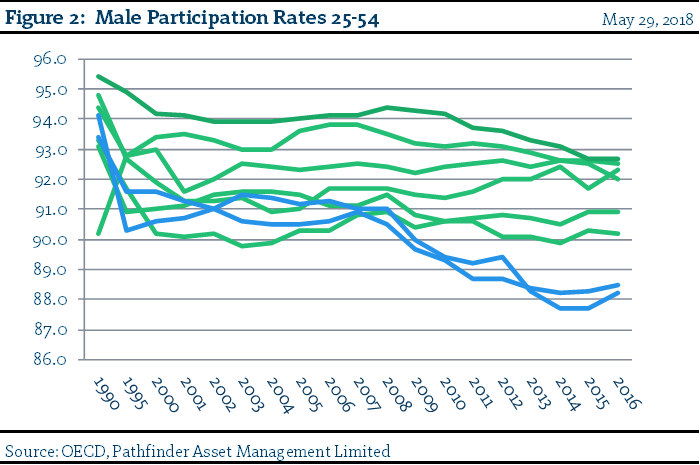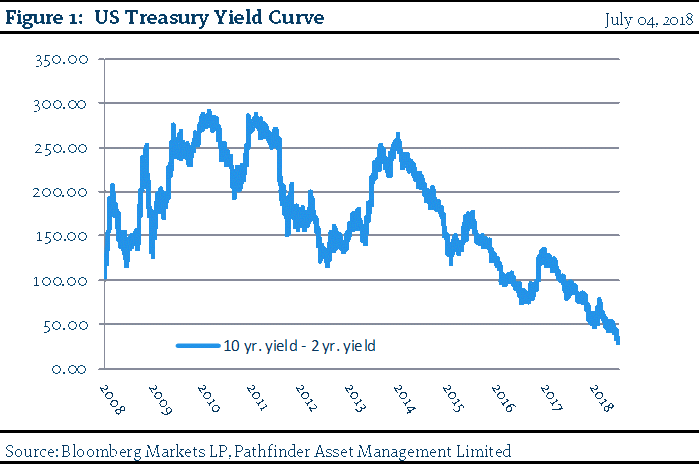Recap & Macro Outlook: US Participation Reconsidered
Figure 2 to the right was featured in our Outlook Vol 8 Ed 11 (here) at the beginning of June. At that time, we wrote participate rates for prime aged working males in the US (blue) had dropped well below other industrialized nations and concluded that, while the US now has more jobs available than workers seeking, if participation rates increased, wage growth and inflation could be lower than expected. We found a paper this week that adds another layer to the discussion. A portion of the abstract is below:
“… about half of prime age men who are not in the labor force (NLF) may have a serious health condition that is a barrier to work. Nearly half of prime age NLF men take pain medication on a daily basis, and in nearly two-thirds of these cases they take prescription pain medication. Labor force participation has fallen more in areas where relatively more opioid pain medication is prescribed, causing the problem of depressed labor force participation and the opioid crisis to become intertwined.” (Krueger, Princeton University)

This is somewhat depressing. Along with demographic, job polarization and health insurance trends, we conclude that low participation rates for prime aged US males could be structural; therefore, may not reverse to pre-2007 levels. This could keep the labour market tight and ultimately contribute to inflation. In Figure 1 to the right, we present the 10-2 yield curve, which is the difference between short and long-term yields on US Treasury bonds. We expect short-term rates to increase with inflation and, other things being equal, come closer to long rates. This will result in a continued flattening and potentially an inversion of the yield curve over the coming years. Inflation, the term structure of interest rates and the discount rates we use to value all assets, are inexorably linked. These inputs are important for our portfolios so we will continue to track this closely.

“This means that” we will continue to focus on investing in real businesses but are also clearly focused on inflation data, interest rate expectations and the yield curve as a harbinger for a potential slowing of the economy in the medium term.
National Instrument 31-103 requires registered firms to disclose information that a reasonable investor would expect to know, including any material conflicts with the firm or its representatives. Doug Johnson and/or Pathfinder Asset Management Limited are an insider of companies periodically mentioned in this report. Please visit www.paml.ca for full disclosures.
*All returns are time weighted and net of investment management fees. Returns from the Pathfinder Partners’ Fund and Partners’ Real Return Plus Fund are presented based on the masters series of each fund. The Pathfinder Core: Equity Portfolio and The Pathfinder Core: High Income Portfolio are live accounts. These are actual accounts owned by the Pathfinder Chairman (Equity) and client (High Income) which contain no legacy positions, cash flows or other Pathfinder investment mandates or products. Monthly inception dates for each fund and portfolio are as follows: Pathfinder Core: Equity Portfolio (January 2011), Pathfinder Core: High Income Portfolio (October 2012) Partners’ Fund (April 2011), Partners’ Real Return Plus Fund (April, 2013), and Partners’ Core Plus Fund (November 2014).
Pathfinder Asset Management Limited (PAML) and its affiliates may collectively beneficially own in excess of 10% of one or more classes of the issued and outstanding equity securities mentioned in this newsletter. This publication is intended only to convey information. It is not to be construed as an investment guide or as an offer or solicitation of an offer to buy or sell any of the securities mentioned in it. The author has taken all usual and reasonable precautions to determine that the information contained in this publication has been obtained from sources believed to be reliable and that the procedures used to summarize and analyze such information are based on approved practices and principles in the investment industry. However, the market forces underlying investment value are subject to sudden and dramatic changes and data availability varies from one moment to the next. Consequently, neither the author nor PAML can make any warranty as to the accuracy or completeness of information, analysis or views contained in this publication or their usefulness or suitability in any particular circumstance. You should not undertake any investment or portfolio assessment or other transaction on the basis of this publication, but should first consult your portfolio manager, who can assess all relevant particulars of any proposed investment or transaction. PAML and the author accept no liability of any kind whatsoever or any damages or losses incurred by you as a result of reliance upon or use of this publication.